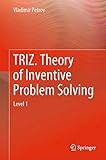TRIZ. Theory of Inventive Problem Solving [electronic resource] : Level 1 / by Vladimir Petrov.
By: Petrov, Vladimir [author.] .
.
Contributor(s): SpringerLink (Online service) .
.
Material type:  BookPublisher: Cham : Springer International Publishing : Imprint: Springer, 2019Edition: 1st ed. 2019.Description: XVI, 221 p. online resource.Content type: text Media type: computer Carrier type: online resourceISBN: 9783030042547.Subject(s): Engineering design
BookPublisher: Cham : Springer International Publishing : Imprint: Springer, 2019Edition: 1st ed. 2019.Description: XVI, 221 p. online resource.Content type: text Media type: computer Carrier type: online resourceISBN: 9783030042547.Subject(s): Engineering designTraditional Technology for Problem Solving -- Review of TRIZ -- System Approach -- Ideality -- Resources -- Contradictions -- Principles of resolving contradictions -- Trends of system evolution.
This introductory book describes the initial (first) level of studying the theory of inventive problem solving (TRIZ) from the series “TRIZ from A to Z,” and presents the most general methods for solving inventive problems and generating new ideas. Chapter 1 examines traditional technologies for problem solving, based on trial and error. Chapter 2 describes the general concept of TRIZ, while Chapter 3 explains the main notions of “system” approaches, like system thinking, system and its hierarchy, system effect, emergency, synergetic effect and systematicity. In turn, Chapter 4 describes the notion of “ideality” and Chapter 5 addresses the notion of resources, their types, and methods for using them. Chapter 6 acquaints readers with one of the most important aspects of TRIZ: contradiction. Chapter 7 describes the inventive principles, while Chapter 8 includes descriptions of the systems of trends proposed by G. Altshuller and the author. In closing, the author makes recommendations on how to most effectively use TRIZ tools, on how readers can improve their knowledge, skills and habits concerning the use of TRIZ, and on how they can hone their inventive thinking skills. The book also features Appendices that include analyses of selected problems, a list of the main websites related to TRIZ, and lists of examples, problems, illustrations, tables and formulae.


There are no comments for this item.